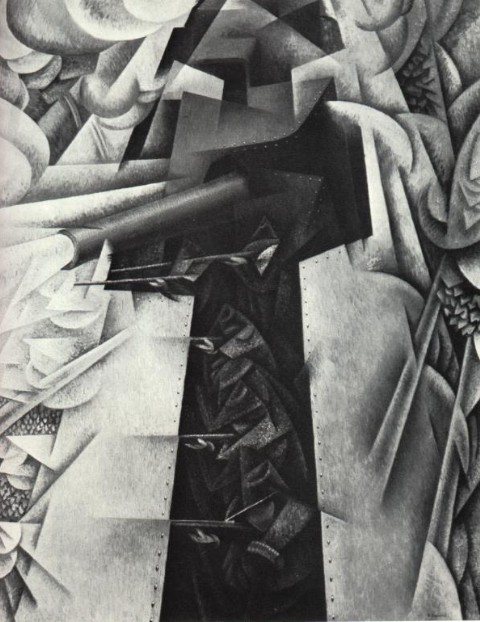

"Man and His World International Fine Arts Exhibition Expo 67 Montréal Canada" by Pierre Dupuy © the Canadian Corporation for the 1967 World Exhibition and the National Gallery of Canada
| Gino Severini. 1883-1966
The Armoured Train. 1915 By the turn of the last century Gino Severini, like his later fellow Futurists, Giacomo Balla and Umberto Boccioni, was in Rome where the Italian Art Nouveau movement was then in vogue. There he studied at the Academy and also under Balla but unlike other Futurists he went to Paris, as early as 1906, and thus could experience Fauvism and the contemporary revival of Pointillism at its fountain-head. He ultimately underwent a strong Cubist influence, without manifesting the jingoistic insistence shown by other Italian Futurists on the primacy and total independence from Cubism of the Italian Furutuist movements. Only late in 1911 did Severini's contacts with the Milan Futurist group become intimate, and, following the First World War until his recent death, he painted in a relatively realistic style based on classical subject-matter. Yet throughout the years just before and during the First World War, Severini was a leading figure within Futurism, of which The Armoured Train provides a synoptic example. In it, all the above-mentioned influences have been integrated into an image which both dramatizes the mechanical nature of modern warfare and, with its suggestion of rapid movement, introduces the idea of the fourth-dimension of time. To achieve this sense of movement, Severini transformed normal one-point perspective into a means of upsetting the very sense of a permanent natural order, for which the Renaissance originally had developed this system of perspective. Severini consequently projected the horizon line and the vanishing point outside and above the picture space, thereby imitating the dizzying experience when we stand between railroad tracks or at the base of a tall building and we shift our eye's focus rapidly from the nearest to the furthest visible point. It is, in fact, the viewer's inability to reconcile the inherent demand both to look into depth and to move our glance upward that most effectively creates a sense of movement in The Armoured Train. Considering the relatively modest speeds of trains in 1915, which, had they been greater, would make the depiction of weapons firing simultaneously in one direction at rapidly passed targets even more unrealistic than, objectively considered, they actually are, Severini's depiction of movement probably owes more to early motion pictures and to such paintings as Marcel Duchamp's Nude Descending the Staircase than to the observation of natural reality. Ultimately, it is to the abstract and diagrammatic linear design, to the psychological impact of the then novel subject-matter, and to the combination of these elements in the rearward firing cannon, which seems to propel the train forward leaving its unreal white stream of exhaust behind, that Severini owes the realization of his aims. And while this work may in part result from the attraction which the dangers of war and lethal weapons held for many Futurists, the abiding interaction between the elements of colour, line and reflected light and from the dazzling surface effect which this produces. |